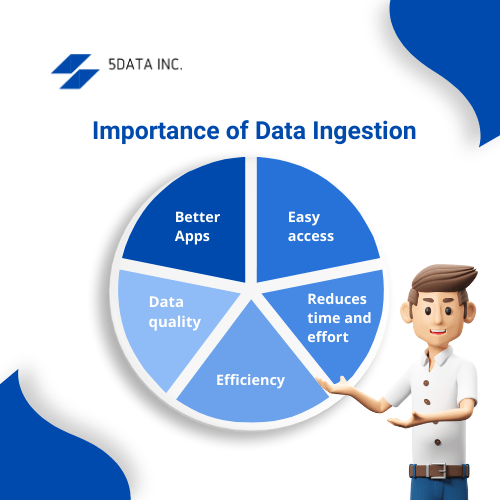Businesses process data for better usage, like solving complex business problems, business intelligence, and business analysis. Today, businesses use data to generate insights and make well-informed business decisions. Data scientists are proving the true potential of data by bringing in novel methods to extract, process, and analyze data.
The massive amount of generated data made it natural for it to evolve into Big Data. Over the years, it has increased exponentially from a few terabytes to many zettabytes. A layered architecture provides every business with an easy and effective way to deal with the multitude of problems faced with data. The layers in the big data architecture can be divided as
- Data ingestion layer
- Data collector layer
- Data processing layer
- Data storage layer
- Data query layer
- Data visualization layer
Our main topic here is data ingestion in the data ingestion layer. Let us dive into the details.
Data Ingestion Layer
Data is acquired from various sources, processed, and pushed through to the next layers of big data architecture from this layer. The data source can mean anything from an RDBMS, CSV, SaaS data, IoT devices, spreadsheets, etc. Connectors form an integral part of this layer and are used to connect to specific data sources.
Data may only be accepted if standards are met while checking data quality. Data can be anything from structured, semi-structured, unstructured, and streaming. Data collection and data management service providers can help you manage your data for a better analysis through best practices.
Benefits Of Data Ingestion
Data Ingestion extracts data from various external sources and then transfers data to a destination, often a data warehouse or a data lake. Data ingestion automates capturing the data, which was otherwise done manually. As the data comes from multiple data sources in different data formats at variable speeds, it is crucial to ingest data properly into a data processing system. The ingested data flows seamlessly through the data pipeline and the next layers. From here, it becomes easy to access the data, analyze it and make effective business decisions.
- Easy access: In the past few decades, unstructured data has surmounted beyond its limit and still growing. Businesses must handle incoming data from various sources consistently and in different formats. Data ingestion makes it easier to deal with this ever-increasing data.
- Reduces time and effort: Sufficient data access is mandatory for business analysis and making successful business decisions. However, acquiring large volumes of data and processing can take time and effort. Data acquisition and transfer are taken care of by data ingestion, making it a faster process.
- Efficiency: An appropriate ingestion model ultimately helps in data analytics and making the right decisions for a business. The efficiency of data analytics systems depends on consistent and accessible data. Data ingestion is the solution.
- Data quality: Using ETL (Extract, Transform, and Load) cited below, business data can be transformed or cleansed to improve the data quality before it is loaded into the storage repository. ETL forms the base for data analytics and machine learning.
- Better apps: Technologically, data ingestion is a role player in helping engineers create better applications with enhanced user experience.
For example, ERP systems have to handle enormous amounts of data in financial, accounting, human resources, sales, procurement, logistics, and supply chain management. ERP implementations can include on-premises, cloud-based and hybrid systems. All this data has to combine and go into a single storage area. Data ingestion can streamline the process to enhance the performance of the ERP systems leading to insightful business decisions and cost-effective business solutions.

Types of Data Ingestion
Distinct techniques can be implemented to extract and transfer data. These techniques form the main components of the data ingestion architecture. They can be classified into two types depending on the data volumes from disparate data sources and data frequency.
Batch-based data ingestion
This data ingestion involves collecting, processing, and transporting in batches in periodic intervals or logical ordering. Fewer computing resources are used for batch processing which considerably improves the affordability of data ingestion. Large-scale data ingestion is done using batch-based data ingestion. The data ingestion framework is commonly used for batch processing of data.
Real-Time Data Ingestion
Real-time processing and time-bound decision-making are possible with this type of ingestion. Data is collected after it’s generated and streamed into a data warehouse. Real-time data ingestion is important where sensitive data is involved, which needs to be processed immediately and stored in the data warehouse for security purposes.
Some data ingestion challenges faced can be listed as follows:
- Acquiring large amounts of data from different sources is a major challenge in data ingestion. Data analytics have largely helped to understand this problem.
- With ever-increasing volumes of data and numerous data sources for a business organization, it becomes difficult to maintain data quality during data ingestion.
- Building a data pipeline for an organization might be time-consuming and resource intensive.
- Scalability is another challenging task with increasing amounts of data and velocity. It calls for scaling up resources like hardware or network bandwidth.
- Data must pass through numerous stages in the ingestion process. It becomes important to check if the data being acquired and transferred is moving through secure channels in the data pipeline.
- Data ingestion pipelines may require integrating with third-party APIs, which may pose greater challenges.
Data Lifecycle Management Services can provide simplified solutions to most challenges. Data Lifecycle Management (DLM) approach is the best way to manage the data lifecycle from creation to deletion of data after it is rendered useless.
Data Ingestion And ETL
ETL stands for Extract, Transform, and Load. The main distinction between data ingestion and ETL is that ETL not only extracts data but also transforms and loads it in a data repository. Several transformation types exist, like aggregation, cleansing, splitting, and joining. ETL is a part of 5DataInc’s Data Lifecycle Management Services. Kindly go through the site for more information on Data ingestion and ETL.
Data Ingestion Tools
The main intention of data ingestion is to extract data from a data source and store it in a target repository. A data ingestion tool automates the data ingestion process by automatically extracting and storing data in a target destination. Some important data ingestion tools are Apache Kafka, Apache NIFI, Wavefront, Data Torrent, and Syncsort.
Data Collection And Data Management Service Providers
Data Management plays a pivotal role in making effective business decisions, and it involves data ingestion, processing, analysis, and caching. At 5DataInc, we understand your business data requirements and provide the right solution for all your Data Lifecycle Management (DLM) issues. Our services include Data ingestion, Data Store, Data Analytics, and Digitization. Our expertise involves giving greater insights into your data by providing the best Data Lifecycle Management Services at 5DataInc.
5DataInc is one of the world’s best Data Collection and Data Management Service Providers with expert analytics. It provides all the Data Lifecycle Management Services to make expert decisions to grow your business and cut through the competition.

